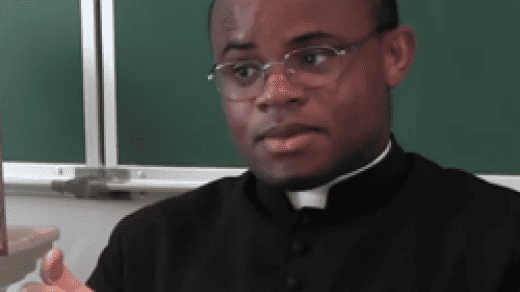It was January 2000. My fellow sophomore classmates had just arrived at the lovely 15th century convent that would be our home for the semester. The nuns had happily ushered us in and were preparing our first night's feast. It had been a very long day. The night before we had left Boston Logan, landed in Amsterdam, and dealt with a 3-hour layover in a terribly dull airport. We then got into Rome, cleared customs as a group, got into our bus, and made our way into the city. We had dinner and about an hour of free time. My roommate and I looked at the map and figured we had enough time to run to St. Peter's, see it, and run back (If you think I'm strong-willed now, the 20-year old me would have knocked you over!). My roommate and I decided to do precisely that.
Now, most visitors to St. Peter's come down the so-called "Via della Conciliazione" which is neither how Bernini wanted his masterpiece to be seen nor how any first-time visitor to St. Peter's should see it. That road was thoughtlessly bulldozed by Mussolini right after the Concordat with the Vatican to remind everyone who was the new duce in Rome.
We were living in Trastavere and so we were on the same side of the Tiber as St. Peter's and so we ran up and came in through the side. Bernini very much wanted the visitor to be overwhelmed as he/she came across his masterpiece after walking through dark, old, narrow streets. In January 2000 I didn't know any of that. I was just running to St. Peter's. I didn't realize we would discover the heart of Catholicism as Bernini had envisioned.
Chris and I came in through the left colonnade. We didn't say a word at first. Any true Catholic's reaction to St. Peter's is at first an emotional one: you are here in the very center of the Holy City: mere steps away from the tomb of St. Peter himself. Then there's the architectural majesty of the basilica. And finally there's the "embrace" of the colonnade, emulating arms embracing all pilgrims. After a few breathless moments, I remember saying, "Wow. I can't believe how amazing it looks." We were both fighting back tears.
We lingered a bit longer, hoping to see a light in the papal apartments (how awesome would it be if we could see the Holy Father, we thought), but we looked at our watches and headed home.
That semester featured many other heart-stopping moments, not just in the Eternal City, but in Venice, Florence, Assisi, Subiaco, Orvieto, and so many other places in Italy. It was so very new to me and as an "SSPX person" at the time I was still of the mind that the Catholic Church still functioned, more or less, in all these places.
I would not return again to Europe until 2009, when I was a convinced sedevacantist (though I was unfortunately still opinionist). For the first time, a sadness crept into my viewings of the churches - wherever I was - Greece, Spain, France, Italy, or England. The story was always the same.
These glories of Christendom were built by the hard work of generations of faithful, who labored to produce something they would not see finished in their lifetime. What would they have done if they had known that in the 21st century there would be a worldwide apostasy of a scale unseen since the time of Arius, that a protestant service masquerading as a Mass would defile these blessed pillars, that these houses of worship would no longer be anything but museums to the glory that was Christendom?
I try to get to five different churches each week here in Paris but I must say I increasingly have to prepare myself for a feeling of dread and sadness that accompanies my awe and wonderment.
I touch pillars and statues. I glance skyward in wonder. I kiss the right foot of innumerable St. Peters, and I say some decades of a rosary in reparation for all we have chosen to willingly lose.
Some weeks ago this hit home particularly in St. Francis Xavier, near Les Invalides. Desperate, clutching beauty all around. The disgusting table of compromise stinking up the sanctuary mere meters from the true altar of sacrifice.
I write these words not to share my gloom nor discourage the young (or old) from discovering the churches of Europe. I wanted to share that once you get past the first time wonder of shiny new travel, and you have time to catch your breath, the sadness will hit you (you'll also see wonders like the idiocy of destroying things that your ancestors made). Those countless red sanctuary lamps are very often false alarms. The words of the prophet Daniel have come true and may ring in your heart:
"When therefore you shall see the abomination of desolation, which was spoken of by Daniel the prophet, standing in the holy place: he that readeth let him understand. Then they that are in Judea, let them flee to the mountains: And he that is on the house-top, let him not come down to take anything out of his house. And he that is in the field, let him not go back to take his coat. And woe to them that are with child, and that give suck in those days. But pray that your flight be not in the winter, or on the sabbath. For there shall be then great tribulation, such as hath not been from the beginning of the world until now, neither shall be. And unless those days had been shortened, no flesh should be saved; but for the sake of the elect those days shall be shortened.
Then if any man shall say to you: Lo here is Christ, or there; do not believe him. For there shall arise false Christs and false prophets, and shall show great signs and wonders, insomuch as to deceive (if possible), even the elect." (St. Matthew XXIV: xv-xxiv)
And yet, amidst that desolation, we can glance around at these glories of Christendom, breathe in the age old smell of incense that still permeates some of these places, and remember another verse:
"But, as it is written: That eye hath not seen, nor ear heard, neither hath it entered into the heart of man, what things God hath prepared for them that love him." (I Corinthians II: ix)
Step inside the European church with that knowledge that all things, in time, will pass away, and let the sadness you may feel turn into great joy.


The same happens here in Spain. But we must remember that even if occupied by the enemy, they are still our home, which we will recuperate, as ancient hebrews were longing for the Temple, and vowing to never forget it.
Also, we should remember what was being shown to V. Katherine Emmerich, how invisible spiritual churches were subsisting above ancient churches and monasteries, whose deceased members were still chanting the Office, even when nothing was remaining of those Houses of prayer.
This is what I think when I enter the deserted Quires of our Cathedrals and Collegiates, praying with all our forefathers who did the same for many centuries, with the same prayers and beliefs.
Mr Stuart
I think that is a an edifying practice!